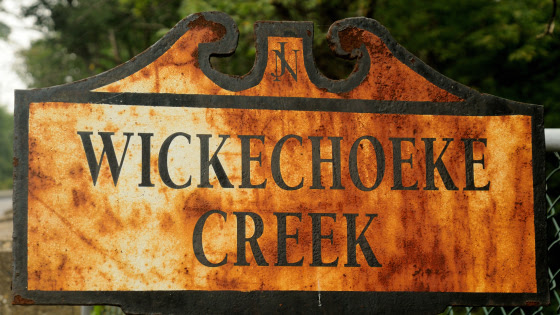Along the South Branch: Connected!
Article and photos by Joe Mish

Bear have no need to read signs, much less pronounce the names of obscure creeks, to figure out where they are going. They just put one foot in front of the other and see where it leads.
Two yearling bears curled up to sleep in a jumbled embrace, to form a single pile of pulsating fur, from which random legs protruded.
Upon waking, one bear walked downhill 500 paces to its right, the other 500 paces left, each bear seeking to satisfy its thirst in the nearby streams.
Rested and full of adventure, thirst satisfied, both bears began to follow their respective stream in the direction the water flowed.
One bear followed Plum Brook to Wickecheoke Creek and ended up on the Delaware River, while its sibling rambled along the Second Neshanic River, to the First Neshanic River, to the Neshanic River, to the South Branch of the Raritan River, to the Raritan River
The two streams, arising from springs, on each side of a common ridge, a mere half mile apart, lead to the state’s opposite coasts. Together the streams form a direct pathway from coast to coast.
We live in a provincial world defined by geopolitical borders, reinforced by the scale of our self-imposed home range. When we travel US route 1 in New Brunswick, we never consider that if we go straight, instead of turning into Chipotle, we end up in Caribou, Maine or the Florida Keys. Same situation as the two bears.
Whether tracing the tracks of a rambling bear down a watery trail to the coast, or a paved highway to opposite ends of the continent, we begin to see a connectivity to distant places. Artificial borders fall away and perspective comes into focus. Taken to the highest resolution, we see that celestial events in the cosmos dictate the requirements and conditions for life on earth.
Adjust the resolution and closer to home we see the Atlantic flyway, a major bird migration route from the arctic to Mexico. Events at either end of the spectrum and along the flyway, can have a dramatic impact on population dynamics of many species.
Preserved lands like the Rachael Carson National Wildlife Refuge in Maine and the Edwin B. Forsythe National Wildlife Refuge in New Jersey are just two of many areas critical to migrating, nesting and overwintering avian activity. Private lands cannot be overlooked and must be appreciated for their valuable contribution outside established state and federal refuges and wildlife management areas.
On a smaller scale, though still expansive, is the critical need for linear greenways in an area broken into isolated segments of habitat.
Many reptiles, amphibians and furbearers are impacted. Isolated populations require a critical amount of genetic variation to remain viable into the future.
Slow moving turtles such as the bog and eastern box turtle are especially threatened. They are now exposed to predators and cars on their journey to lay eggs or migration forced by habitat loss. To celebrate the establishment of isolated patches of open space is misplaced, if a pathway is not considered.
Concerned with isolated habitat and lack of greenways connecting them, the State of NJ, Dept of Environmental Protection, Natural and Historic Resources, Div of Fish and Wildlife, has established a program to examine the impact of isolated habitat and genetic variation. Their program is CHANJ- Connecting Habitat Across New Jersey.
“The goal of this project is to collect DNA samples from a variety of native, terrestrial mammal species across NJ that represents the spectrum of movement capabilities. The genetics analysis will help us understand the impact of landscape fragmentation and road barriers on wildlife mobility.”
I have volunteered to participate and collect tissue samples from roadkill or harvested animals. Please contact me if you spot a fresh roadkill other than deer; jjmish57@msn.com
Far away places exist only in our limited imagination, programmed with a distorted sense of scale. Put one foot in front of the other and see where it leads.
Author Joe Mish has been running wild in New Jersey since childhood when he found ways to escape his mother’s watchful eyes. He continues to trek the swamps, rivers and thickets seeking to share, with the residents and visitors, all of the state’s natural beauty hidden within full view. To read more of his writing and view more of his gorgeous photographs visit Winter Bear Rising, his wordpress blog. Joe’s series “Nature on the Raritan, Hidden in Plain View” runs monthly as part of the LRWP “Voices of the Watershed” series. Writing and photos used with permission from the author.
